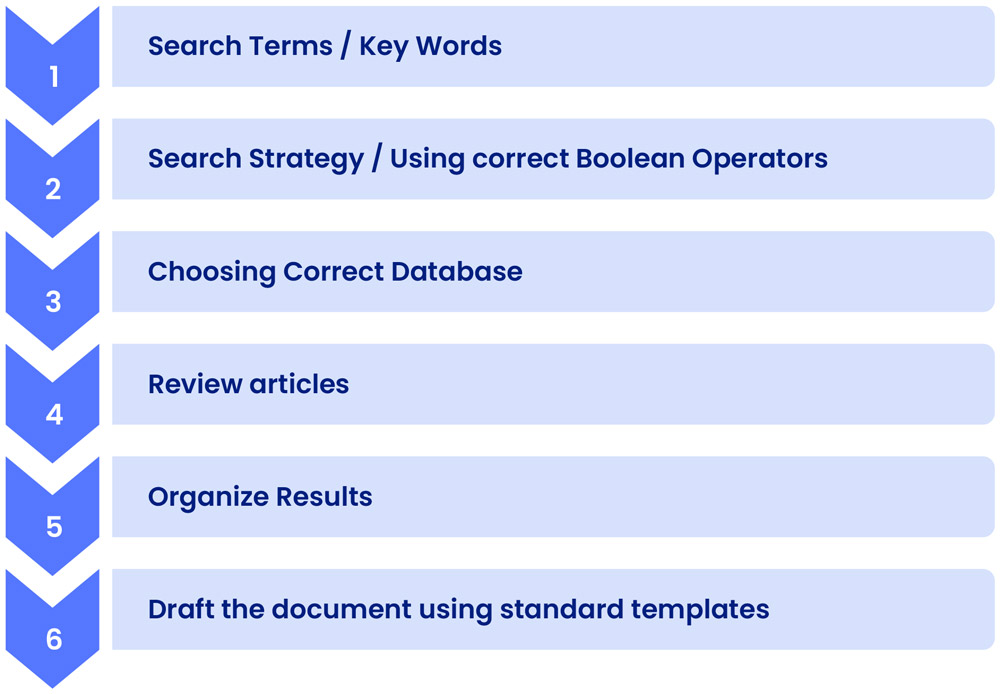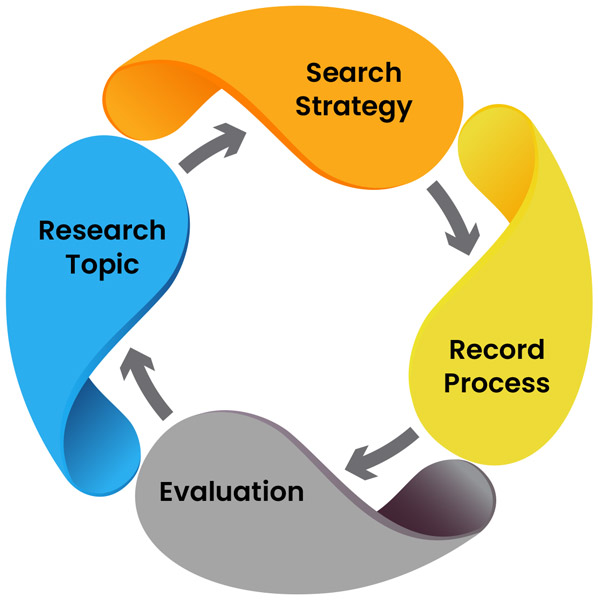A thorough and organized search of the previously published data is known as a literature search, and it is used to find a variety of high caliber references on a certain subject. There are several reasons to perform a literature search, such as gathering data for the creation of guidelines based on evidence, completing a phase in the research process, or participating in an academic evaluation. But the major goal of a comprehensive literature search is to identify research questions by analyzing the existing literature and looking for any gaps that could potentially benefit from more investigation.
A research challenge usually involves a topic that the researcher is interested in and somewhat knowledgeable with. It must be directed by concentrating on material that has not previously been investigated. After the problem has been narrowed down, finding and evaluating previous research may help to further clarify the study strategy.
A well-crafted statement outlining the expectations for the investigation’s course is called a research hypothesis. It is among the most crucial instruments for assisting in the resolution of the research question. It should make sense, have all the required parts, and pose an inquiry that can be looked into and tested.
While conducting a thorough and time-consuming literature search can seem daunting, there are a few easy measures to organize and streamline the process. Developing the research questions and organizing the search are the most crucial steps. A critical step in the clinical evaluation of medical devices is reviewing the literature.
A medical device’s benefit-risk profile is evaluated in the clinical evaluation report to guarantee its continuous compliance, safety, and efficiency. The literature search and review, which summarizes the clinical data and establishes the current state-of-the-art as well as the behavior of a medical device on the market, is an essential component of the clinical evaluation report.
The clinical evaluation report (CER) certifies that medical devices and MEDDEV are in line with the European Medical Device Regulation (MDR; 2017/745). 2.7 rev. The clinical review method for medical devices is outlined in MEDDEV 2.7 rev 4 along with the prerequisites for the literature search, which include looking up pertinent literature, gathering research, and elucidating how the clinical data relates to the safety and efficiency of the medical device.
Why need an excellent literature review?
For many manufacturers of medical devices, the majority, if not all, of the clinical information they get on their products during device development and later clinical evaluation updates comes from literature searches. During clinical evaluation, it can be used to illustrate and assess the device’s safety and effectiveness.
A literature search ensures a summary of the important clinical data regarding the many aspects of a company’s technology and performance, even if the company has conducted clinical studies.
Last but not least and perhaps most significantly the literature search is required for clinical evaluation reports under the EU MDR and will assist in determining if the CE mark is granted to the medical device.
A good literature search provides the following:
- The context for a problem
- Its proposed solution
- A disease/condition or medical process problem
- The intervention is designed to treat or solve it
It should quickly summarize the maximum amount of published literature.
How literature searches can improve other medical device processes?
Medical device development
Throughout the medical device development process, a literature review is useful for a variety of reasons. It serves to inform the R&D team about previous efforts, assist them understand how a new device fits into the market, and help them decide whether to pursue a project.
A strong literature review is one that facilitates the communication of manufacturers’ ideas to investors, partners, and other relevant parties.
Compared to other approaches, such as reading articles detailing the technology or viewing a video, reading a thorough literature study can help you better comprehend the value and risks/benefits of a device.
Post-market surveillance and post-market clinical follow-up
Even though the clinical evaluation literature review focuses mostly on pre-market surveillance, the clinical data acquired can be very helpful in designing the post-market surveillance program for medical devices.
A literature evaluation can assist in persuading regulatory agencies that the benefit-risk ratio of a novel technology is sufficient to justify its approval. It also aids in proving the efficacy, safety, and intended usage of the products, among other claims made by the companies that manufacture them. Additionally, it can be incorporated into marketing products like brochures and videos as clinical data. This can help healthcare practitioners comprehend how a new product differs from older equipment, which is especially crucial when launching it to the market. It is helpful to have a document that outlines the specific flaws in the current medical device designs that the new device is intended to address, as well as how the fictional gadget will function in the marketplace.
Things every Medical Writer must know about Literature Search:
Even when everything else goes right, one might not get the relevant results expected from the literature review. This can be due to incorrect framing of the research question, needing to understand exactly how the search terms interact with the database, or even problems with choosing suitable databases to search.
Practical tips for medical device clinical literature searches

Search terms/Key words:
- Be clear about the topic.
- Generate 2 to 3 key terms that fully reflect what we are looking for. Consider the following:
- Synonyms e.g. Paracetamol/Acetaminophen
- Alternative terminology e.g. Cardiovascular diseases or CVD. Hydrochlorothiazide or HCTZ
- Alternative spelling e.g. tumour/tumor, paediatric/pediatric
- Any related terms e.g. pressure sores or decubitus ulcers
- Variations in word endings (singular, plural) e.g. Child/Children
Search Strategy/Boolean operators:
When providing advice on literature reviews, Boolean operators are consistently mentioned, and with good reason. The success of the literature searches (and sanity) depends on the choice of Boolean operator.
Operators save time by allowing the literature review to be narrowed down to just include pertinent papers. Similarly, if there are insufficient results, the search might be expanded.
The operators AND, OR, and NOT are the most well-known. Be prudent with them.
Plan search:
- Systematic: Try to find all relevant material.
- Retrospective: Find the most recent material and work backwards.
- Citation: Follow leads from useful articles, books and reading lists.
- Targeted: Restrict topic and focus in on a narrow area of the literature

Other search techniques:
- Reference chaining: Follow up references from reference lists of relevant articles
- Documenting a search
- Helps to avoid duplication, allows replication in future
- e.g. date of search, sources searched, no. of hits, details of strategy, etc.
Choose databases wisely:
The results of the literature review will not always come from the same databases because they are not created equal. As a result, searching through several databases is necessary in order to obtain articles pertinent to the device.
Ex: A search for “Silk fibroin AND (dermal OR filler OR “dermal filler” OR “soft tissue augmentation”)” will, for instance, produce three results in PubMed, 16,700 results in Google Scholar, and 181 results in LIVIVO when conducted without any filters.
Some of these variations result from the way the search engines operate, while others are caused by the many publications that are included in each database. To obtain useful results in each database, it is imperative to comprehend how each one operates and how to phrase phrases from a literature.
study. In the event if the devices are aiming for a CE Mark under EU MDR, use databases that provide an extensive and worldwide (with an EU emphasis) result set.
Be organized:
Reviews of the literature can provide a wealth of information, especially when it comes to dealing with devices in bigger domains like orthopedics and cardiovascular surgery. It is crucial to critically assess all of that information, though.
Before beginning, a simple procedure for conducting a literature search must be established; that is, a literature search protocol must be written. It is important to have every step in order before beginning; otherwise, it is simple to become disoriented halfway through or, worse, nearly finished.
Always conduct a preliminary search to see what comes up in terms of publications and material, as well as to test different search phrases. Once the desired outcome has been identified, along with a strategy for reaching it, prepare a thorough search plan. Provide the search parameters, inclusion/exclusion standards, important ideas, databases to be searched, and search tools to be used. Draft the protocol for the literature search.
Review articles/Use digital tools to make your life easier:
This explosion of information makes it increasingly difficult for researchers to keep up with the latest developments in the field. In addition to the apparent challenge of maintaining new content, many researchers face another challenge: understanding the context, methods and goals of the research presented. Often they can only be understood by reading the papers in detail. Therefore, members of the regulatory team must read, organize and report on many articles. The increasing addition of articles by the scientific community has created a flood of information. It is simply impossible for many regulatory agencies and medical professionals to carefully read all the search results to find relevant information for clinical evaluation reports (CER). There is a lot of painstaking detail work and moving parts in a literature search, and there is no need to complicate things, by using as many digital tools as possible to make life easier. Download search results, use citation management, and make sure the right software was used when viewing data. Some digital tools have spent years refining and improving their systematic literature review software platform so that it is easy to use and can save enormous hours on a review project.
Draft the document using standard templates:
Keeping track of which databases have searched and which search terms used will help to avoid wasting time by repeating the searches at a later date. Normally need to register and login to a database to save searches online.
Artificial intelligence and clinical data processing
Artificial Intelligence (AI) is not new, and AI enables great collaboration between humans and machines, the best of which is yet to come. However, currently available software can significantly reduce the workload for medical device manufacturers in preparing literature reviews and clinical evaluation reports. Manufacturers have more control over the data screening process and data extraction in an automated process than manual. Several automated programs with integrated artificial intelligence and machine learning allow users to create tags, filters, customize inclusion criteria and research questions for the data extraction process, and an index to balance precision and recall. Some have summarization and reporting tools that highlight hidden relationships in textual data.
In addition, automatic bias assessment and probe detection ensure that the automated approach requires little human intervention beyond the search strategy. Interactive machine learning systems are easier than what we think. For example, some software offers data visualization, meta-analysis, evidence synthesis, and text mining, which can be very useful for literature screening and clinical data evaluation.
Conclusion:
A literature search not only provides an opportunity to learn more about a particular topic, but also provides insight into how previous analysts have studied the topic. It helps to interpret ideas, discover gaps and identify opportunities. In short, systematic and well-organized research can help in the design of new research.
Over the years, MakroCare has catered to several complex scientific literature projects for the medical devices field. To know more about MakroCare’s scientific literature service capabilities, book an appointment today!


